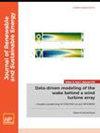基于鲯鳅排水特性的局部压痕处理机翼气动性能优化研究
IF 1.9
4区 工程技术
Q4 ENERGY & FUELS
引用次数: 0
摘要
提高机翼的空气动力性能是优化风力涡轮机等旋转机械能量收集效率的关键。本文以海豚在推进过程中的鳍侥幸的碗状轮廓为灵感,提出了一种在机翼压力面上产生凹面区域的局部压痕方法。选取 NACA 0018 翼面作为参考翼面,在后缘点附近采用两种处理方式:刚性变形和柔性变形。基于网格量独立性和实验结果验证,结果表明与原始机翼相比,局部压痕方法可以改变压痕部分自身的压力分布,优化机翼的整体气动性能。整个机翼的升力系数随着压痕深度的增加而逐渐增大,并最终达到一个稳定值。定量结果表明,当压痕深度 D = 0.020c 时,整个机翼的升力系数最多可提高 26.27%;当压痕深度 D = 0.010c 时,机翼的升阻比达到最大值,比原机翼的升阻比提高了 16.39%。当用柔性介质代替刚性压痕部分时,流过压力面的流体与柔性介质相互作用。本文提出的局部压痕方法可为优化机翼气动外形和提高风力发电机的能量收集效率提供有价值的参考。本文章由计算机程序翻译,如有差异,请以英文原文为准。
Optimization study on airfoil aerodynamic performance with local indentation treatment based on drainage characteristics of dolphin fluke
Enhancing the aerodynamic performance of airfoils is the key to optimizing the energy harvesting efficiency of rotating machinery such as wind turbines. Motivated by the bowl-shaped outline of the dolphin's fluke during the propulsion process, this paper proposes a local indentation method that generates a concave region on the pressure surface of the airfoil. The NACA 0018 airfoil is selected as the reference airfoil, and two types of treatments are applied near the trailing edge point: rigid deformation and flexible deformation. Based on the grid quantity independence and experimental results validation, the results demonstrate that compared with the original airfoil, the local indentation method can modify the pressure distribution of the indentation section itself and optimize the airfoil's overall aerodynamic performance. The lift coefficient of the whole airfoil increases gradually with the rise in the indentation depth and reaches a stable value eventually. Quantitative results reveal that when the indentation depth D = 0.020c, the lift coefficient of the whole airfoil can increase by up to 26.27%; when the indentation depth D = 0.010c, the airfoil's lift-to-drag ratio reaches the maximum, which is 16.39% higher than that of the original airfoil. When replacing the rigid indentation section with a flexible medium, the fluid flowing over the pressure surface interacts with the flexible medium. The method of local indentation proposed in this paper can provide valuable reference for optimizing the aerodynamic profile of airfoils and improving the energy harvesting efficiency of wind turbines.
求助全文
通过发布文献求助,成功后即可免费获取论文全文。
去求助
来源期刊

Journal of Renewable and Sustainable Energy
ENERGY & FUELS-ENERGY & FUELS
CiteScore
4.30
自引率
12.00%
发文量
122
审稿时长
4.2 months
期刊介绍:
The Journal of Renewable and Sustainable Energy (JRSE) is an interdisciplinary, peer-reviewed journal covering all areas of renewable and sustainable energy relevant to the physical science and engineering communities. The interdisciplinary approach of the publication ensures that the editors draw from researchers worldwide in a diverse range of fields.
Topics covered include:
Renewable energy economics and policy
Renewable energy resource assessment
Solar energy: photovoltaics, solar thermal energy, solar energy for fuels
Wind energy: wind farms, rotors and blades, on- and offshore wind conditions, aerodynamics, fluid dynamics
Bioenergy: biofuels, biomass conversion, artificial photosynthesis
Distributed energy generation: rooftop PV, distributed fuel cells, distributed wind, micro-hydrogen power generation
Power distribution & systems modeling: power electronics and controls, smart grid
Energy efficient buildings: smart windows, PV, wind, power management
Energy conversion: flexoelectric, piezoelectric, thermoelectric, other technologies
Energy storage: batteries, supercapacitors, hydrogen storage, other fuels
Fuel cells: proton exchange membrane cells, solid oxide cells, hybrid fuel cells, other
Marine and hydroelectric energy: dams, tides, waves, other
Transportation: alternative vehicle technologies, plug-in technologies, other
Geothermal energy
 求助内容:
求助内容: 应助结果提醒方式:
应助结果提醒方式:


